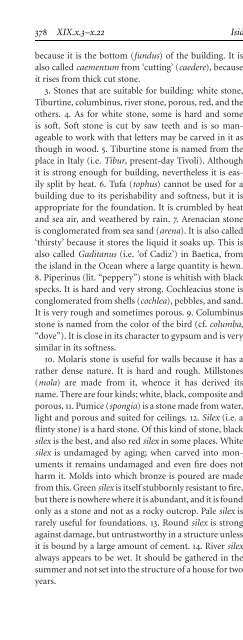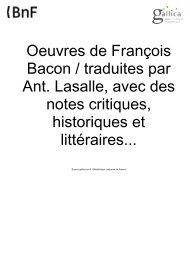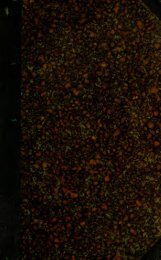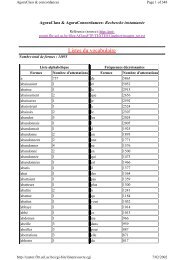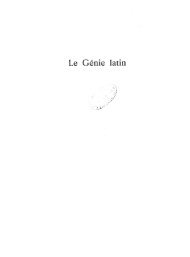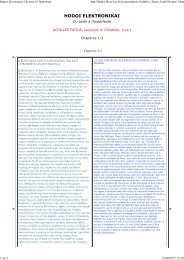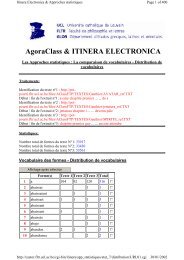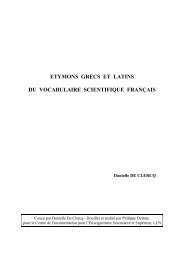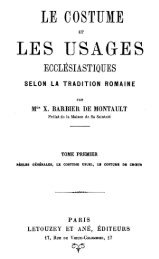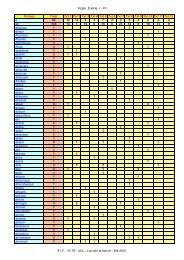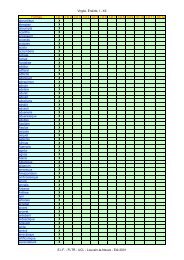The Etymologies of Isidore of Seville - Pot-pourri
The Etymologies of Isidore of Seville - Pot-pourri
The Etymologies of Isidore of Seville - Pot-pourri
You also want an ePaper? Increase the reach of your titles
YUMPU automatically turns print PDFs into web optimized ePapers that Google loves.
378 XIX.x.3–x.22 <strong>Isidore</strong> <strong>of</strong> <strong>Seville</strong><br />
because it is the bottom (fundus) <strong>of</strong>the building. It is<br />
also called caementum from ‘cutting’ (caedere), because<br />
it rises from thick cut stone.<br />
3. Stones that are suitable for building: white stone,<br />
Tiburtine, columbinus, river stone, porous, red, and the<br />
others. 4. Asforwhitestone,someishardandsome<br />
is s<strong>of</strong>t. S<strong>of</strong>t stone is cut by saw teeth and is so manageable<br />
to work with that letters may be carved in it as<br />
though in wood. 5. Tiburtine stone is named from the<br />
place in Italy (i.e. Tibur, present-day Tivoli). Although<br />
it is strong enough for building, nevertheless it is easily<br />
split by heat. 6. Tufa (tophus) cannotbeusedfora<br />
building due to its perishability and s<strong>of</strong>tness, but it is<br />
appropriate for the foundation. It is crumbled by heat<br />
and sea air, and weathered by rain. 7. Arenacian stone<br />
is conglomerated from sea sand (arena). It is also called<br />
‘thirsty’ because it stores the liquid it soaks up. This is<br />
also called Gaditanus (i.e. ‘<strong>of</strong> Cadiz’) in Baetica, from<br />
the island in the Ocean where a large quantity is hewn.<br />
8. Piperinus (lit. “peppery”) stone is whitish with black<br />
specks. It is hard and very strong. Cochleacius stone is<br />
conglomerated from shells (cochlea), pebbles, and sand.<br />
It is very rough and sometimes porous. 9. Columbinus<br />
stone is named from the color <strong>of</strong> the bird (cf. columba,<br />
“dove”). It is close in its character to gypsum and is very<br />
similar in its s<strong>of</strong>tness.<br />
10. Molarisstoneisuseful for walls because it has a<br />
rather dense nature. It is hard and rough. Millstones<br />
(mola) are made from it, whence it has derived its<br />
name. <strong>The</strong>re are four kinds; white, black, composite and<br />
porous. 11.Pumice (spongia)isastonemadefromwater,<br />
light and porous and suited for ceilings. 12. Silex (i.e. a<br />
flinty stone) is a hard stone. Of this kind <strong>of</strong> stone, black<br />
silex is the best, and also red silex in some places. White<br />
silex is undamaged by aging; when carved into monuments<br />
it remains undamaged and even fire does not<br />
harm it. Molds into which bronze is poured are made<br />
from this. Green silex is itself stubbornly resistant to fire,<br />
but there is nowhere where it is abundant, and it is found<br />
only as a stone and not as a rocky outcrop. Pale silex is<br />
rarely useful for foundations. 13. Roundsilex is strong<br />
against damage, but untrustworthy in a structure unless<br />
it is bound by a large amount <strong>of</strong> cement. 14. Riversilex<br />
always appears to be wet. It should be gathered in the<br />
summer and not set into the structure <strong>of</strong> a house for two<br />
years.<br />
As far as building with clay is concerned, baked bricks<br />
are suited for walls and foundations, while curved and<br />
flat tiles are suitable for ro<strong>of</strong>s. 15. ‘Flat ro<strong>of</strong>-tiles’ (tegula)<br />
are so named because they cover (tegere) abuilding,<br />
and ‘curved tiles’ (imbrex)because they receive the rain<br />
(imber). Tegula is the primary term, and tigillum (lit.<br />
“small plank”) is the diminutive. 16. Smallbricks(laterculus)are<br />
so called because their stretched-out (latus)<br />
shape is formed by four boards placed all the way around.<br />
Bricks (later) are unfired, and they also are so named<br />
because when ‘stretched out’ (latus) they are shaped<br />
with wooden forms. 17. Some <strong>of</strong> these forms are called<br />
cratis, the wicker forms in which people are accustomed<br />
to carry the clay for these unfired bricks. <strong>The</strong>y<br />
are interwoven from reeds, and named after the term<br />
(“hold”), that is, because they hold on to each<br />
other.<br />
18. Somepeopleclaim that mud (lutum) isnamed<br />
by antiphrasis, because it is not clean, for every thing<br />
that has been washed (lavare, ppl. lotus), is clean. 19.<br />
Quicklime (calcis viva; i.e. calx viva) 4 is so called because<br />
although it may be cold to the touch, it contains fire<br />
hidden inside, and for this reason, when water is poured<br />
on it, the hidden fire immediately bursts forth. Its nature<br />
produces something amazing, for after it has caught fire<br />
it burns in water, which usually extinguishes fire, and<br />
it is extinguished by oil, which usually ignites fire. Its<br />
use is essential in constructing a building, for one stone<br />
cannot adhere strongly enough to another unless they<br />
are joined with lime. 20.Gypsum(gypsum)isarelative<strong>of</strong><br />
lime, and it is a Greek term (i.e. ). <strong>The</strong>re are many<br />
kinds. <strong>The</strong> best <strong>of</strong> all is good as ‘translucent stone’ (lapis<br />
specularis; see XVI.iv.37 above), and it is most pleasing<br />
in the images on buildings and in cornices. 21. Sand<br />
(arena, i.e. harena)isnamed from dryness (areditas, i.e.<br />
ariditas), not from clinging (adhaerere)inconstruction,<br />
as some people claim. It passes the test if it squeaks when<br />
pressed in the hand or if no stain remains when it is<br />
spread out on a white cloth.<br />
22. Columns (columna) are named for their length<br />
and roundness (cf. colus, “distaff”; see xxix.2 below);<br />
the weight <strong>of</strong> the entire building rests on them. <strong>The</strong><br />
ancient ratio was that a third <strong>of</strong> the height <strong>of</strong> the columns<br />
4 <strong>The</strong> ‘quick’ <strong>of</strong> English ‘quicklime’ also means “living,” that is,<br />
unslaked, chemically more active.


